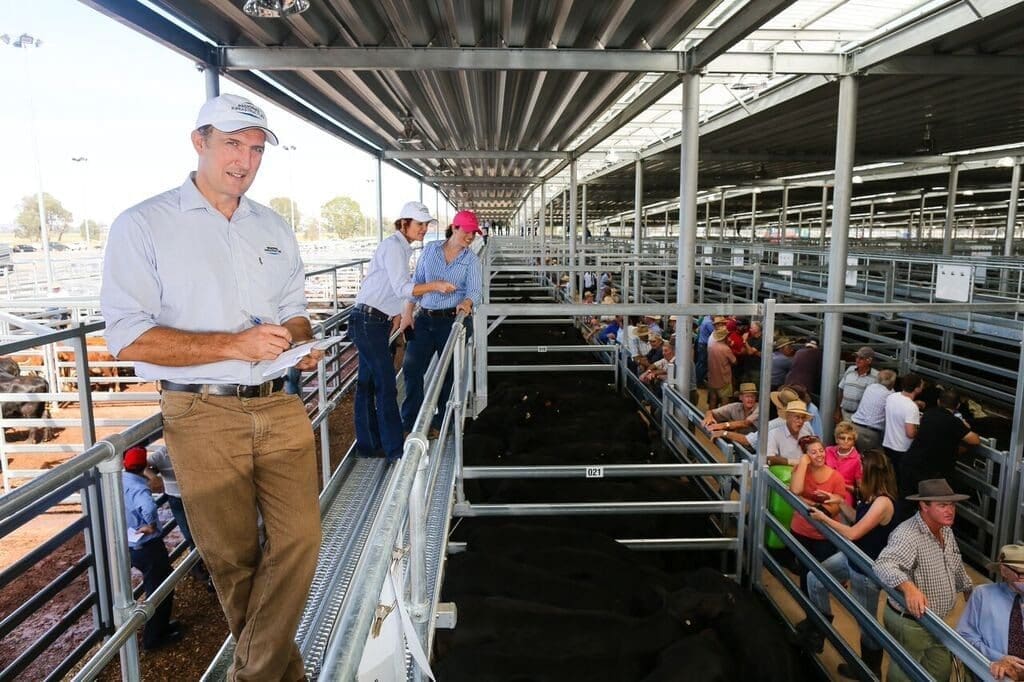WELL-DESIGNED stockyards and stock handling areas – whether they’re new or upgraded existing facilities – can help to reduce injuries and downtime among personnel, as well as creating less stress on the livestock.
That has been the experience of livestock exchange centre operator Regional Infrastructure Pty Ltd, which has significant experience operating six of Australia’s biggest regionally-based livestock selling centres in Victoria, NSW and Queensland.
RIPL has seen a marked decline in reportable safety incidences, medically-treated injuries and injury-related downtime thanks to design features built into its newest state-of-the-art facility, which opened this year near Wodonga, in Victoria.
Since planning started for the $25 million Northern Victoria Livestock Exchange (NVLX) site, safety has been a priority for all operations and activities involving saleyard employees, users, customers and visitors.
RIPL safety and compliance manager Ted Parish says there are many work health & safety systems and safety features incorporated in the NVLX facility.
Some of these include:
- Erecting shelters across stock yards/pens
- Setting up efficient stock loading and unloading areas
- Sealing or watering yards, walkways and adjacent roads to reduce dust
- Designing walkways and races that clearly separate people from stock
- Using appropriate flooring and providing water and feed in yards/pens
- Having appropriate pen densities
- Ensuring yards and crushes are working well and maintained in good condition and using air operated equipment where possible
- Providing training/induction for all staff working at the site.
With 216 selling pens and 80 dual-purpose pens, the NVLX has capacity to handle 6000-head of cattle in a single sale and 270,000-head of cattle each year.
“Based on our experience in dealing with these high volumes of livestock and how they prefer to move through saleyards, this facility has been purpose-built with user-safety issues forefront in our minds,” Mr Parish said.
“Where possible we let the cattle rest before they enter the facility and all of our managers and employees are trained in low stress livestock handling methods.”
He said minimising dust around saleyards with sprinkler systems and soft flooring was particularly important to reduce the likelihood of employees being impacted by dust.
“To minimise dust issues, producers could use sprinklers, hoses or fire-fighting equipment to wet their stock yards and surrounding roads down before cattle are bought in,” Mr Parish said.
“It doesn’t have to be an elaborate sprinkler system, like we have set up at the NVLX.”
Other features include the installation of roof shelter over the 1.8 hectares of selling areas and pens to ensure operator and animal comfort, elevated walkways, good ventilation and skylights.
With thousands of people using its livestock exchanges every week, RIPL has devised a comprehensive WH&S manual that outlines safe operating policies such as training requirements, data recording, hazard identification and emergency responses in the case of any safety incidences.
“We’ve learned valuable lessons over the years, which we’ve put in place in this facility to minimise WHS issues, improve efficiencies and productivity, and reduce animal stress and business costs,” Mr Parish said.
“Even on a smaller scale, formalising WH&S protocols and safety guidelines can provide benefits. It means everyone dealing with livestock in a business understands what is expected of them, there is reduced risk of injuries and – over time – a good safety culture develops.
Points to consider include:
- guidelines to ensure operators don’t climb on the top and sides of livestock crates
- ensuring that there is awareness of power lines and other hazards when loading livestock
- ensuring that slippery areas in and around yards and pens are clearly identified, and
- ensuring that staff are not working when fatigued.
“It is also important to remember that regular maintenance of yards and equipment is vital to user-safety, especially for crushes, races and loading areas. These need to be fit-for-purpose and well looked after,” Mr Parish said.
Guide provides assistance
Help is available for farmers unsure of how to put together a WHS plan, through a guide prepared on behalf of the Primary Industries Health and Safety Partnership (PIHSP).
It pulls together all the legal requirements in each state; provides extensive web links to the information employers need to comply with; and includes a step by step guide to drafting a plan for individual businesses.
Copies of Work Health and Safety Legislative Responsibilities and more information about the Partnership can be found at www.rirdc.gov.au/PIHSP.
The goal of the Partnership is to improve the health and safety of workers and their families in farming and fishing industries across Australia. It is funded by the Australian Meat Processor Corporation, Meat & Livestock Australia, and the Cotton, Grains and Rural Industries Research and Development Corporations.
Source: PIHSP.

